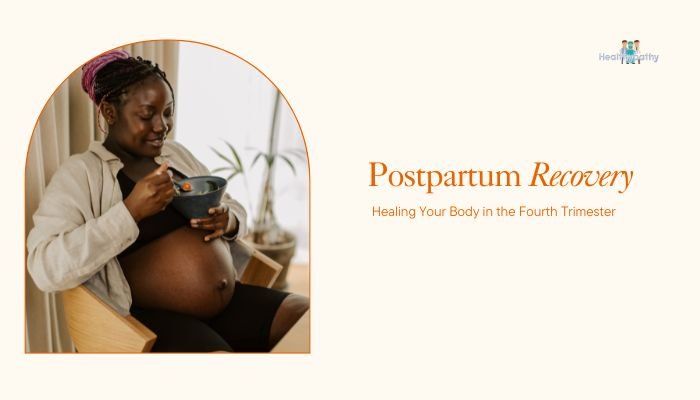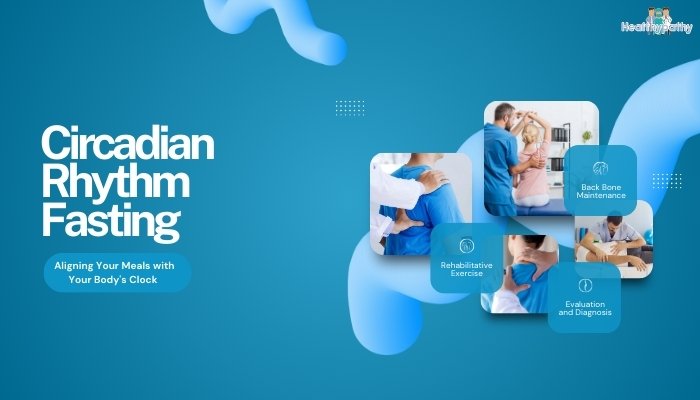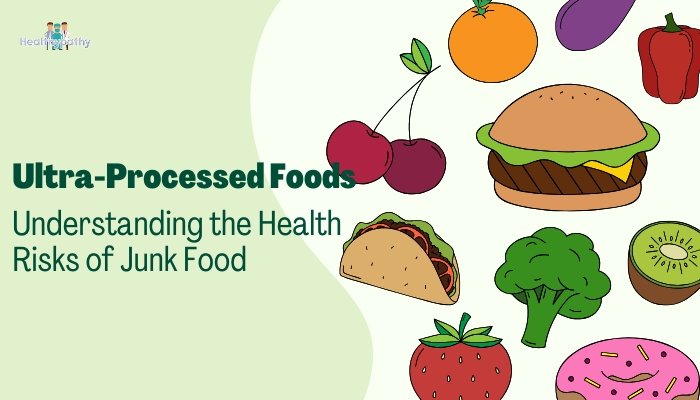Introduction
The postpartum period, often called the “fourth trimester,” is a phase of transition and adaptation for new mothers and their infants. It typically spans the first 12 weeks after childbirth, though some changes can extend beyond that timeframe. During these weeks, a woman’s body heals from pregnancy and delivery while adjusting to hormonal shifts, sleep deprivation, and caring for a newborn. Many emotional and physical factors intertwine, influencing how a mother experiences and recovers from childbirth.
Postpartum recovery differs for each person. Some heal quickly, while others face challenges such as pain in the perineum, prolonged bleeding, or feelings of depression. Women who deliver by cesarean may encounter extra surgical discomfort, whereas those who have a vaginal birth might deal with perineal tears or swelling. Regardless of the type of birth, supportive care, balanced nutrition, rest, and gentle movement can help rebuild strength and emotional resilience.
This article provides an in-depth overview of postpartum healing. It covers physical changes in the uterus and pelvic floor, healing after cesarean or vaginal tears, nutrition, breastfeeding basics, sleep management, postpartum mental health, and tips for gradually reintroducing exercise. Each aspect works together to create a balanced recovery that supports the new mother’s well-being and fosters a healthy environment for her infant.
The Fourth Trimester Defined
The fourth trimester refers to the postpartum period when a woman’s body and mind transition from pregnancy to the non-pregnant state. Although postpartum changes continue well beyond 12 weeks, this timeframe includes significant physical healing and emotional adjustments. New mothers experience hormone shifts, dramatic changes in sleep patterns, and a fundamental shift in daily focus. Body systems that adapted to pregnancy now return to prior states, which can feel both relieving and challenging.
Key Themes of the Fourth Trimester
- Physical Healing: The uterus shrinks back, tissue tears or incisions heal, and muscles that expanded to accommodate the baby regain strength.
- Hormonal Adjustments: Estrogen and progesterone levels drop, influencing mood, lactation, and energy levels. Prolactin increases for breastfeeding.
- Emotional Shifts: Heightened emotional sensitivity, anxiety over newborn care, and potential mood fluctuations occur.
- Infant Bonding: New parents learn the rhythms of feeding, soothing, and nurturing, which brings both joy and fatigue.
A compassionate support system is vital during this phase. Partners, family, friends, and postpartum care providers can help by sharing tasks, offering emotional support, and encouraging rest.
Physical Changes and Healing
Uterine Involution
One of the most significant postpartum processes is uterine involution, where the uterus contracts and returns near its pre-pregnancy size. Immediately after childbirth, the uterus is firm and sits just below the navel. Over the next six weeks, it gradually shrinks. Women often feel mild to moderate cramping, sometimes called “afterpains,” more pronounced during breastfeeding. This happens because the hormone oxytocin triggers uterine contractions, helping control bleeding and aiding involution.
Ways to Support Uterine Involution:
- Frequent Breastfeeding: Natural oxytocin release aids contractions.
- Gentle Abdominal Support: Holding a small pillow against the abdomen can ease discomfort when coughing or sneezing.
- Monitoring Bleeding: Lochia (postpartum bleeding) starts bright red, changes to pinkish-brown around days 4–10, and may become yellowish-white by week 3 or 4. Heavier-than-expected flow or large clots should prompt medical evaluation.
Vaginal Tears and Perineal Soreness
Some vaginal deliveries involve perineal tears or episiotomies. Tissues around the vaginal opening may tear naturally as the baby emerges, or a small incision (episiotomy) may be made to enlarge the opening. Healing can involve soreness, swelling, and mild bruising in the initial weeks.
Tips for Perineal Healing:
- Perineal Ice Packs: Applying cold packs to the perineum in the first 24–48 hours eases pain and inflammation.
- Sitz Baths: Sitting in warm, shallow water for 10–15 minutes promotes circulation, cleanses the area, and soothes discomfort.
- Topical Solutions: Witch hazel pads or medicated sprays can ease burning or itching.
- Pelvic Floor Exercises: Gentle Kegel exercises (when ready) increase blood flow and help restore muscle tone.
If stitches are present, they usually dissolve over a few weeks. Signs like severe pain, foul odor, or increased redness might indicate infection and warrant prompt medical attention.
Cesarean Section Recovery
A cesarean birth involves a surgical incision through the abdominal wall and uterus. This is a major procedure, requiring specific care to heal well. Many women stay in the hospital for two to four days after a cesarean, though full internal recovery can span several weeks or months.
C-Section Recovery Essentials:
- Incision Care: Keep the area clean and dry. Follow guidelines for changing dressings and monitor for signs of infection (redness, warmth, discharge).
- Activity Modification: Avoid heavy lifting or vigorous exercise in the early weeks. Gentle walks can promote blood flow.
- Pain Management: Medications or over-the-counter pain relievers may be prescribed. Always follow dosing directions and monitor for side effects.
- Supporting the Abdomen: A postpartum support band or pillow can stabilize abdominal muscles when coughing or getting up from bed.
If there are concerns such as fever, unusual drainage, or intense pain around the scar, medical advice can clarify if stitches have opened or if there is an underlying infection.
Pelvic Floor Health
Pregnancy and childbirth place added weight on the pelvic floor muscles. Hormonal changes increase elasticity, but as the uterus enlarges over months, those muscles may stretch or weaken. A weakened pelvic floor can lead to urinary incontinence or an increased risk of organ prolapse.
Rebuilding Pelvic Floor Strength:
- Kegel Exercises: Contract and lift pelvic floor muscles for three to five seconds, then relax. Begin with shorter holds and progress gradually.
- Physical Therapy: Women with significant incontinence or prolapse may benefit from specialized postpartum pelvic rehab.
- Posture Awareness: Keeping the spine aligned reduces pressure on the pelvis.
- Gradual Progression: Exercises should not cause pain. If discomfort or heaviness persists, a pelvic floor specialist can advise on advanced techniques.
Strengthening the pelvic floor builds a stable foundation that supports daily movements and helps prevent long-term problems like urinary leaks.
Emotional Well-Being in the Postpartum Period
Emotional changes can be as pronounced as physical ones. Hormones shift abruptly after placental delivery, and fatigue from feeding schedules can amplify stress. Support, open communication, and self-awareness help guide new mothers through these shifts.
Baby Blues vs. Postpartum Depression
Up to 80% of women experience baby blues in the first weeks postpartum. Common signs include mood swings, tearfulness, or irritability. While challenging, baby blues usually ease as sleep patterns stabilize and mothers gain confidence in infant care.
On the other hand, postpartum depression is more severe and persistent. Women might feel deep sadness, hopelessness, or an inability to bond with the baby. Some experience intrusive thoughts or guilt about not being a “good enough” mother. These symptoms can escalate if left unaddressed.
Warning Signs of Postpartum Depression:
- Persistent low mood or anxiety beyond two weeks.
- Difficulty functioning or completing basic tasks.
- Loss of interest in activities previously enjoyed.
- Thoughts of harming oneself or the baby.
Healthcare providers, therapists, or support groups can offer crucial help. Social support from family and peers eases isolation, while counseling or medication might be necessary if depression is moderate or severe.
Anxiety, Stress, and Sleep Deprivation
New mothers often lack consistent rest, as newborns wake frequently to feed. Sleep disruption can elevate anxiety, reduce patience, and make daily tasks seem overwhelming. Women who face prior mental health challenges may find that the postpartum environment intensifies those conditions.
Strategies to Manage Anxiety and Sleep Deprivation:
- Seeking Help: Partners, relatives, or friends can mind the baby for short periods so the mother can rest.
- Safe Co-Sleeping Practices or Room-Sharing: Arranging the baby in a nearby bassinet can simplify night feedings.
- Prioritizing Tasks: Letting go of non-urgent tasks (like extensive cleaning) preserves energy for essential care activities.
- Mindful Breathing: Taking slow, controlled breaths can regulate stress responses.
If anxiety disrupts everyday functioning, talking with a counselor or joining a postpartum support group can help mothers feel less alone.
Postpartum Nutrition
A balanced, nutrient-rich diet supports tissue repair, hormone balance, and steady energy during this demanding phase. Eating enough calories, including protein and healthy fats, bolsters the mother’s recovery and aids in lactation.
Building a Supportive Eating Plan
- Protein Intake: Lean meats, dairy, legumes, or plant-based proteins promote tissue healing and steady energy levels.
- Complex Carbohydrates: Whole grains and starchy vegetables offer vitamins and a slow release of energy.
- Healthy Fats: Avocados, nuts, seeds, and fatty fish (like salmon) provide essential fatty acids linked to mood regulation.
- Fruits and Vegetables: Vitamins, minerals, and antioxidants fuel recovery and support the immune system.
- Hydration: Drinking enough water is crucial, especially for breastfeeding mothers who lose fluids through milk production. Some may need 2.7–3.7 liters of fluid daily from beverages and water-rich foods.
Practical Tips for Busy New Mothers
- Meal Prepping: Friends or family can help cook simple meals or freeze pre-made portions.
- Snack Stocking: Keep quick, nutrient-dense options (nuts, yogurt, cut fruit) easily accessible for middle-of-the-night feeding sessions.
- Light Supplements: Iron or multivitamins can address anemia or nutrient gaps. Healthcare providers can confirm if supplements are appropriate.
- Frequent, Small Meals: Eating in smaller portions throughout the day prevents energy drops and helps with digestive comfort.
Good nutrition and hydration foster more consistent energy, better mood stability, and steady milk supply for those who breastfeed.
Breastfeeding Essentials
Many new mothers choose to breastfeed for its immune and nutritional advantages. However, learning proper latching and managing milk supply can be challenging, especially if the mother is exhausted from delivery.
Latching and Positioning
Achieving a comfortable latch is key. If the baby is positioned well, nursing sessions are less painful, and milk transfer is more efficient. Mothers can hold the baby so that the chin touches the breast first, and the baby’s nose is at the nipple level. Proper alignment ensures the areola is in the baby’s mouth, not just the nipple.
Common Positions:
- Cradle Hold: Baby’s head rests in the bend of the mother’s elbow, with the baby’s chest facing the mother’s torso.
- Cross-Cradle: Offers additional head support by placing one arm behind the baby’s head, especially useful for new moms learning to nurse.
- Football Hold: Ideal for mothers recovering from cesarean, as it keeps the baby’s weight off the incision site.
- Side-Lying: Good for nighttime feeds or mothers with perineal soreness. The mother and baby lie on their sides, facing each other.
Nipple pain or cracking in the first days can happen, but persistent or severe pain may signal latch issues. Lactation consultants guide new mothers toward effective positioning, assist with common complications like engorgement, and offer personalized feeding strategies.
Rest and Self-Care
The demands of newborn care leave many new mothers feeling physically and mentally depleted. Self-care involves short, regular breaks for recovery and stress relief. Even 10–15 minutes of quiet time can help.
Setting Realistic Expectations
Newborn routines are unpredictable, and many mothers compare their experiences to romanticized images of motherhood. Understanding that postpartum recovery requires patience helps reduce self-criticism.
Ways to Embrace Self-Care:
- Short Naps: Sleeping when the baby sleeps can mitigate fatigue, even if it’s only in small increments.
- Journaling: Writing down daily experiences, anxieties, or small triumphs fosters self-awareness.
- Gentle Massage: Soft abdominal or back massage can relax sore muscles.
- Delegation: Family members or friends can handle chores or errands, allowing the mother to rest.
Finding Emotional Support
Emotional health benefits from open dialogue. Confiding in a trusted partner or friend about insecurities, anxieties, or doubts can lessen isolation. Online forums or postpartum groups connect mothers with peers facing similar challenges. When these resources are not enough, professional counseling or a therapist skilled in postpartum issues can help reframe thoughts and clarify coping strategies.
Movement and Exercise
Exercise in the postpartum period must be gradual. The body needs time to heal, and heavy physical strain can aggravate injuries or prolong soreness. However, gentle motion aids circulation, supports mood, and can reduce some postpartum aches.
Timeline for Reintroducing Activity
- First Few Weeks: Short walks, mild stretching, and pelvic floor exercises are typically appropriate if there are no significant medical concerns.
- After 4–6 Weeks: Many doctors offer clearance for low-impact aerobic activity, postpartum yoga, or gentle strengthening. Women with complicated births or severe tearing may need more time before resuming exercise.
- Beyond 8–12 Weeks: Gradually increasing exercise intensity can follow if the mother feels comfortable, monitors bleeding, and does not strain healing tissues.
Types of Postpartum Exercises
- Pelvic Floor Work: Focus on Kegels and gentle bridging.
- Core Re-Engagement: Diaphragmatic breathing or pelvic tilts help rebuild abdominal strength without overloading the midsection.
- Walking or Light Cardio: Stroller walks allow for fresh air, mild activity, and bonding time with the baby.
- Modified Strength Training: Bodyweight movements and resistance bands can be introduced slowly.
Women recovering from cesarean sections should exercise extra caution until abdominal incisions have healed sufficiently. Any sharp pain, bleeding changes, or increased discharge indicates the need to scale back activity and seek medical advice.
Relationship and Family Dynamics
The arrival of a baby reshapes household roles and routines. A mother who is healing may rely heavily on a partner or extended family for cooking, cleaning, or caring for older children. While these changes can unite families, they can also strain relationships if communication is lacking.
Ways to Maintain Healthy Communication:
- Express Needs Clearly: Partners cannot guess every need. Simple statements of how someone can help are often welcome.
- Share Infant Care: Partners participating in diaper changes, burping, or nighttime soothing strengthen their bond with the baby and lighten the mother’s load.
- Plan Quality Time: Even short, focused conversations or cuddling sessions can nurture the connection between partners.
- Set Boundaries with Visitors: Family and friends often want to meet the new baby. Deciding how and when to host visitors prevents undue stress or overstimulation.
Positive communication and balanced responsibilities help both parents adapt to the demands of new parenthood and maintain a supportive environment.
Sexual Intimacy and Contraception
Physical healing, hormonal shifts, and fatigue can affect libido during the postpartum period. Vaginal dryness is common, especially while breastfeeding, due to low estrogen levels. Emotional readiness also varies. Some mothers feel closer to their partner, while others need additional time for healing before resuming intercourse.
Considerations for Postpartum Intimacy:
- Timing: Many healthcare providers recommend waiting four to six weeks to allow tears or incisions to heal and to minimize infection risk.
- Lubrication: Water-based lubricants can alleviate dryness or discomfort during intercourse.
- Gentle Approach: Start slowly, and communicate openly about sensations or pain.
- Contraception: Ovulation can resume before the first postpartum period, so couples who want to avoid another pregnancy may discuss birth control (condoms, progestin-only pills, intrauterine devices) with a provider.
If intercourse remains painful or if fear of intimacy persists, a gynecologist or pelvic floor therapist can evaluate scar tissue, dryness, or muscle tension that may require targeted treatment.
Warning Signs and When to Seek Help
Most women heal well with standard postpartum care, but certain symptoms require medical attention:
- Fever or Chills: Possible sign of infection.
- Excessive Bleeding: Passing clots larger than a golf ball or soaking pads rapidly.
- Severe Abdominal or Pelvic Pain: Could indicate infection, uterine or bladder issues, or a tear complication.
- Red, Swollen Breast Tissue with Flu-Like Symptoms: Suggestive of mastitis during breastfeeding.
- Signs of Deep Vein Thrombosis: Leg swelling, redness, or sharp calf pain.
- Worsening Depression or Suicidal Thoughts: Any form of severe mental distress.
Prompt medical evaluation can prevent complications and promote safer recovery. Regular checkups with an obstetrician or midwife remain essential during the first six weeks postpartum to monitor healing, discuss contraception, and address concerns.
Long-Term Considerations
Recovery from childbirth extends beyond the immediate postpartum phase. Hormone levels stabilize over several months, and the body continues to adapt to motherhood’s demands. Women who maintain healthy habits often experience fewer lingering aches or mood imbalances.
Fostering Lifelong Well-Being:
- Continued Pelvic Floor Care: Periodic exercises or follow-ups with a pelvic therapist sustain muscle tone.
- Regular Health Screenings: Pap smears, breast exams, and other checkups remain a vital part of ongoing health.
- Mindful Nutrition and Exercise: Balanced meal plans and moderate fitness routines contribute to energy and stable weight.
- Support Networks: Parenting groups, close friends, and family help normalize the ups and downs of raising a child, reducing isolation.
Balancing self-care with childcare responsibilities preserves energy and emotional reserves. When postpartum healing evolves into sustained wellness, mothers often feel more confident in all areas of life.
Conclusion
The postpartum phase, or fourth trimester, is a critical window for healing and adaptation. Mothers navigate uterine involution, tissue repair, and emotional shifts while learning to care for a newborn. Balanced rest, gentle exercise, nutritional support, and mental health awareness form the foundation of a successful recovery. Support from partners, family members, and professionals can ease the challenges that appear in the early weeks.
Pelvic floor exercises help restore muscle tone, especially after childbirth. C-section incisions require careful attention to minimize complications, while perineal tears mend through a combination of ice packs, warm sitz baths, and gradual movement. Breastfeeding, though sometimes complex, can be rewarding when latch techniques and postpartum nutritional practices align. Mood swings are common but often improve with proper rest and emotional support. If depression or anxiety escalate, professional intervention is beneficial.
Recovery is a marathon rather than a sprint. The body’s return to balance continues past the immediate fourth trimester. By recognizing signs of complications early, staying informed, and reaching out for help when needed, new mothers can nurture both themselves and their babies, laying a strong groundwork for long-term health and bonding.
References
- Romano M, Cacciatore A, Giordano R, La Rosa B. Postpartum period: three distinct but continuous phases. J Prenat Med. 2010;4(2):22–25.
- Ross-McGill H, Hewison A, Hirst J, Roden J, Bradshaw E. The experiences of women with perineal trauma. J Adv Nurs. 2000;32(5):1152–1158.
- Betran AP, Torloni MR, Zhang JJ, Gülmezoglu AM. WHO statement on caesarean section rates. BJOG. 2016;123(5):667–670.
- Mørkved S, Bø K. The effect of postpartum pelvic floor muscle training on urinary incontinence after different modes of delivery. Clin Obstet Gynecol. 2017;60(4):812–823.
- O’Hara MW, McCabe JE. Postpartum depression: current status and future directions. Annu Rev Clin Psychol. 2013;9:379–407.
- Abdollahi F, Zarghami M, Azhar MZ, Sazlina SG, Lye MS. Predictors and incidence of post-partum depression: a longitudinal cohort study. J Obstet Gynaecol Res. 2014;40(12):2191–2200.
- Barger MK. Maternal nutrition and perinatal outcomes. J Midwifery Womens Health. 2010;55(6):502–511.
- American Academy of Pediatrics. Breastfeeding and the use of human milk. Pediatrics. 2012;129(3):e827–e841.
- DiBari JN, Yu SM, Chao SM, Lu MC. Use of postpartum care: predictors and barriers. J Pregnancy. 2014;2014:530769.
- Daly SE, Owens LA, Hughes AJ, O’Loughlin G, Daly S. The effect of postpartum exercise on mother and baby: a pilot study. J Womens Health (Larchmt). 2020;29(6):858–866.
- Chopin N, Letombe B, Fellahi JL, Dujardin F, Touzet S, Boulanger L, et al. Physical activity and exercise training in postpartum depression: systematic review and meta-analysis. J Affect Disord. 2021;294:214–223.
- Stumbo S, Avery M. Women’s perceived needs for postpartum support: an integrative review. J Obstet Gynecol Neonatal Nurs. 2016;45(6):772–783.







